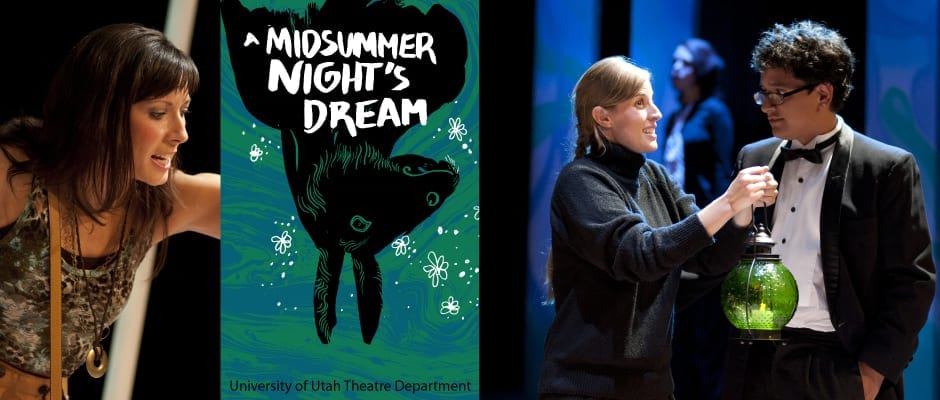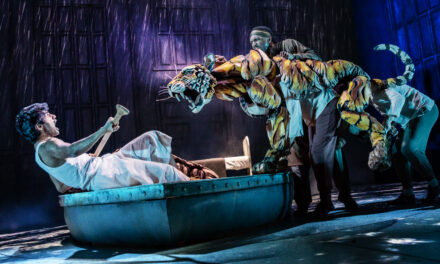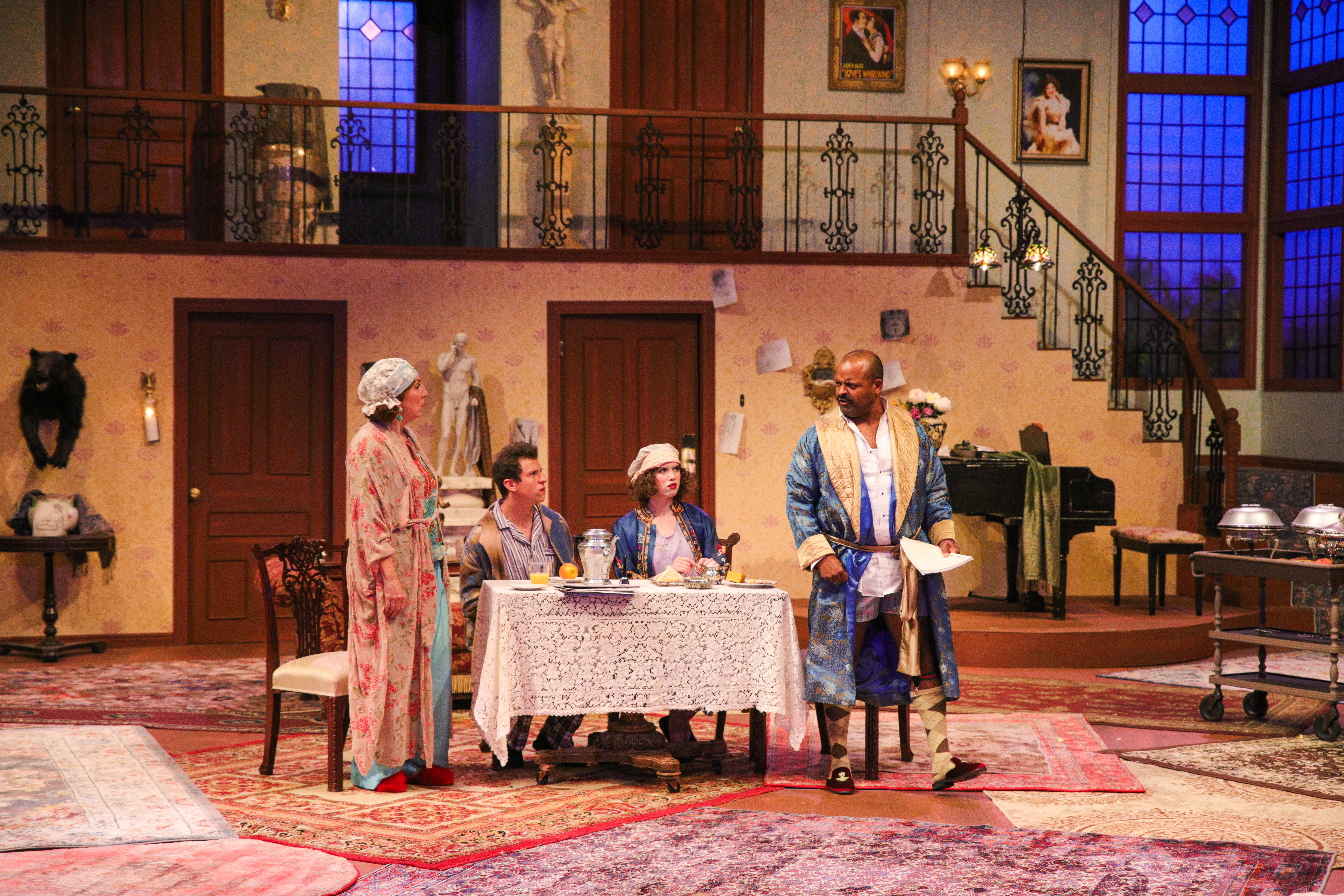SALT LAKE CITY — By far the most popular playwright whose work we review at UTBA is William Shakespeare. With this review, UTBA has now reviewed 20 productions of the works of William Shakespeare, and this is the sixth review that I have written of a Shakespeare production. I think that this is a sign of the appreciation that the audiences of Utah have for the works of the Bard.
A Midsummer Night’s Dream is probably Shakespeare’s most popular comedy (This is the third production that UTBA has reviewed of the play this year.) and I’ve probably seen it seven or eight times. The play is a lighthearted tale of mixups and magic as two groups of mortals enter the forest outside of Athens and are subject to the wiles of the fairy folk, especially Robin Goodfellow—commonly known as Puck. The University of Utah Theatre Department decided to mount a production of the play to kick off their fall season in the Babcock Theatre.
As I entered the Babcock, my attention was drawn immediately to the set (designed by Nanya Ramey), which consisted of a tiered stage with the lowermost level at the middle of the downstage area. The stage was carpeted in white and several white bars extended from the floor to the ceiling. Around three sides of the stage at the topmost level were a series of abstractly painted panels. Finally, several white wooden lawn chairs were set in various locations around the stage. Overall, the stage was certainly not reminiscent of a forest glade. At first, I thought that the abundance of white was cold and sterile, but as the evening continued I saw that the paleness of the set was one of its strengths because it easily took on the color of the lights. As the setting changed from the city of Athens to the forest to the fairy realm, the lights (designed by Ethan Olsen) helped the set change colors from white to green or purple. By the end of the play, I was convinced that this versatility was worth losing the sylvan look that you often see with sets for Midsummer.
The set also fit nicely into director Risa Brainin’s overall concept. Brainin decided to set A Midsummer Night’s Dream in the 21st century. Although I feel like this emphasized the basic humanity of the characters, I feel that some aspects of the concept were forced. For example, Brainin decided to make the fairies into hippies, which to me don’t have as much whimsy and fantasy as Shakespeare’s original fairies do. I also don’t understand why Brainin switched the genders of Titania, Oberon, Bottom, and Flute. Although it could merely be for the purposes of giving better roles to some of the female actors, I felt like Brainin was trying to make an artistic statement by making a fundamental change in these characters. If this is so, then I missed the message. (Puck was also played by a woman, though I consider that a gender neutral role.) Similarly, I don’t understand why Brainin had Hippolyta stay on stage and listen to the young lovers’ plans to escape to the forest. By keeping an extra body on upstage moving around, I felt distracted from the important expository dialogue that characters like Lysander and Helena were delivering. However, Branin is a competent director, and she knew how to briskly move this comedy along and to keep the audience entertained with stage business and humor.
The acting in this production was also competent, though few performers stand out in my mind. Probably the most interesting performance was delivered by Summer Spence in her roles as Hippolyta and Oberon. Spence eschewed a commanding, domineering Oberon for one who holds sway over Puck and the rest of his realm through reason. Her Hippolyta was also more interesting than some I’ve seen, for her sorrow in being a prize of conquest in the first act was apparent on her face as she contemplated what would become of her freedom under the rule of her new lord and husband, Thesus (Stuart Ford). I was disappointed, however, in Ford’s portrayal of Thesus. Thesus is the Duke of Athens and the victor of a war. As such, I imagine that he should be powerful and in command of his environment. Ford’s Thesus, however, did more pleading and supplicating than I had ever seen the role, and I think that it did not work for the character. However, Ford was much more interesting and entertaining as Titania.
I was also disappointed in the choices that the director and actors made for the roles of Puck (Olivia Roberts-Ostler) and Bottom (Marin Kohler), which are two of the most iconic roles in the play. As Puck, Roberts-Ostler was less of the traditional trickster spirit, and more of a sly medium through which Oberon’s wishes were fulfilled. I didn’t like this choice because in Shakespeare’s day, a “puck” was actually the name of a type of spirit or demon who played tricks on mortals and other spirits. To me, avoiding this aspect of the character is like avoiding the supernatural character of the witches in Macbeth: doing so robs the character of the very nature of who they are. As for Bottom, Kohler and Brainin made a Bottom who has very few hallmarks of the character’s rustic qualities in the script. Instead, the Bottom in this production is much more sophisticated, sporting a beret and was more theatrically savvy than what I’ve seen in other productions. Again, this portrayal disappointed me because much of the humor surrounding Bottom (and the rude mechanicals in general) originates in their provincial nature. By giving Bottom hipster qualities, it becomes harder to laugh at the jokes in the script that make fun of his lack of sophistication.
The four young lovers, though, were entertaining, especially as they became entangled in the magic environs of the forest. I was particularly impressed by the performance of Karen Salazar as Hermia. When Hermia awoke the first time in the forest and found her beloved Lysander had disappeared (in order to chase after Helena), Salazar seemed genuinely distraught and distressed. Similarly, when she was fighting with Helena later in the play, she appeared to be completely enraged at the taller woman, and I wondered if a physical fight would break out. I also enjoyed Laura Melton as Helena, who was the perfect foil for Salazar’s rage and appeared to have genuine feelings for Lysander (especially in Act V as the two characters were watching the play within the play). However, the lovers (including Daniel Lara as Lysander and Andres Ricci as Demetrius) sometimes seemed to be acting in isolation. I rarely saw an emotional connection between characters who were in love with each other, and I found myself wondering—for example—why Hermia wanted to elope with Lysander when there seemed to be few sparks between them.
Were there flaws in this production? Yes. Is it my favorite version of A Midsummer Night’s Dream? No. But is it a good production? Yes. I say this in spite of my complaints because this is such a strong script that almost any professional director and minimally competent cast can turn A Midsummer Night’s Dream into a wonderful evening of entertainment. The language is gorgeous and I often found myself swept away as I heard the familiar lines carefully glide off the actors’ tongues. This is (in my opinion) Shakespeare’s most accessible script and the dialogue contains almost no subtext—which makes the actors’ and director’s jobs easier and frees them up to explore more creative options than a typical script offers. Although I didn’t like many of the choices that Brainin and her cast made, I applaud them for daring to try a new Midsummer Night’s Dream instead of playing it safe. The final result is still a pleasure and a reminder of the sheer beauty and strength of one of Shakespeare’s most popular works.








